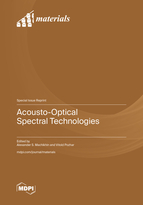Acousto-Optical Spectral Technologies
A special issue of Materials (ISSN 1996-1944). This special issue belongs to the section "Optical and Photonic Materials".
Deadline for manuscript submissions: closed (20 July 2023) | Viewed by 31054
Special Issue Editors
Interests: acousto-optics; spectral imaging; image processing; digital holography
Special Issues, Collections and Topics in MDPI journals
Interests: acousto-optics; spectroscopy; spectral imaging; acousto-optical materials
Special Issues, Collections and Topics in MDPI journals
Special Issue Information
Dear Colleagues,
It is our pleasure to invite you to submit a manuscript for this Special Issue. Full papers, communications, and reviews are all welcome. Acousto-optic technologies have increasingly attracted attention of scientists and engineers. Acousto-optic interactions have become the flexible basis of compact and robust devices for the analysis of the intensity, spectrum, polarization, and other properties of light. In this Special Issue, modern trends of acousto-optical spectral technologies, including the fundamentals and optimization of existing techniques, are highlighted and discussed.
This Special Issue will deal with research including but not restricted to the following:
- Acousto-optic materials and structures for UV, visible, IR, and THz ranges;
- Theoretical and experimental studies of light diffraction by ultrasonic waves;
- Acousto-optic and photoacoustic spectroscopy;
- Spectral imaging and tomography;
- Multispectral and hyperspectral acousto-optic imagers;
- Acousto-optic image and signal processing;
- Acousto-optic interference techniques;
- Novel applications in remote sensing, biomedicine, and industry.
This Special Issue also provides a forum for reports on technical developments that allow the spectral analysis of various objects. The goal of this Issue is to give readers an overview of the hot topics and the state of the art regarding the applications of acousto-optic spectroscopy techniques.
Dr. Alexander S. Machikhin
Prof. Vitold Pozhar
Guest Editors
Manuscript Submission Information
Manuscripts should be submitted online at www.mdpi.com by registering and logging in to this website. Once you are registered, click here to go to the submission form. Manuscripts can be submitted until the deadline. All submissions that pass pre-check are peer-reviewed. Accepted papers will be published continuously in the journal (as soon as accepted) and will be listed together on the special issue website. Research articles, review articles as well as short communications are invited. For planned papers, a title and short abstract (about 100 words) can be sent to the Editorial Office for announcement on this website.
Submitted manuscripts should not have been published previously, nor be under consideration for publication elsewhere (except conference proceedings papers). All manuscripts are thoroughly refereed through a single-blind peer-review process. A guide for authors and other relevant information for submission of manuscripts is available on the Instructions for Authors page. Materials is an international peer-reviewed open access semimonthly journal published by MDPI.
Please visit the Instructions for Authors page before submitting a manuscript. The Article Processing Charge (APC) for publication in this open access journal is 2600 CHF (Swiss Francs). Submitted papers should be well formatted and use good English. Authors may use MDPI's English editing service prior to publication or during author revisions.
Keywords
- Acousto-optics
- Acousto-optical materials
- Bragg diffraction
- Acousto-optic spectroscopy
- Spectral imaging
- Acousto-optic devices
- Acousto-optic image processing
- Microscopy and tomography







